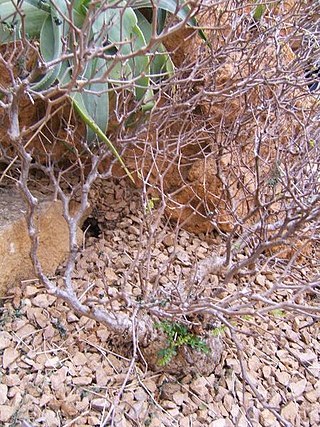
The Anacardiaceae, commonly known as the cashew family or sumac family, are a family of flowering plants, including about 83 genera with about 860 known species. Members of the Anacardiaceae bear fruits that are drupes and in some cases produce urushiol, an irritant. The Anacardiaceae include numerous genera, several of which are economically important, notably cashew, mango, Chinese lacquer tree, yellow mombin, Peruvian pepper, poison ivy, poison oak, sumac, smoke tree, marula and cuachalalate. The genus Pistacia is now included, but was previously placed in its own family, the Pistaciaceae.

Operculicarya is a plant genus in the family Anacardiaceae. They are small dioecious pachycaul trees originated from Madagascar. They mainly grow in dry, rocky areas.

Dracophyllum is a genus of plants belonging to the family Ericaceae, formerly Epacridaceae. There are 61 species in the genus, mostly shrubs, but also cushion plants and trees, found in New Zealand, Australia, Lord Howe Island and New Caledonia. The name Dracophyllum, meaning dragon-leaf, refers to their strong outward similarity to the unrelated Dracaena, sometimes known as dragon tree. Although dicotyledonous, they resemble primitive monocots with their slender leaves concentrated in clumps at the ends of the branches; they are sometimes called grass-trees.

The genus of the myrrhs, Commiphora, is the most species-rich genus of flowering plants in the frankincense and myrrh family, Burseraceae. The genus contains approximately 190 species of shrubs and trees, which are distributed throughout the (sub-) tropical regions of Africa, the western Indian Ocean islands, the Arabian Peninsula, India, and South America. The genus is drought-tolerant and common throughout the xerophytic scrub, seasonally dry tropical forests, and woodlands of these regions.

Anacardioideae is a subfamily of plants in the family Anacardiaceae.

Pentachlaena is a genus of flowering plant belonging to the Sarcolaenaceae family, endemic to Madagascar. It was first scientifically described in 1920.

Protorhus is a small genus of Afrotropical trees in the family Anacardiaceae. It is dioecious, with male and female flowers on separate plants.
The term Micronychia may refer to
Fegimanra is a small genus of trees in the subfamily Anacardioideae of the cashew and sumac family Anacardiaceae. They grow naturally in west and west-central tropical Africa.

Schizolaena is a genus of trees and shrubs in the family Sarcolaenaceae. They are endemic to Madagascar.
Perrierodendron is a genus of trees and shrubs in the family Sarcolaenaceae. They are endemic to Madagascar.
The anthophytes are a grouping of plant taxa bearing flower-like reproductive structures. They were formerly thought to be a clade comprising plants bearing flower-like structures. The group contained the angiosperms - the extant flowering plants, such as roses and grasses - as well as the Gnetales and the extinct Bennettitales.
Micronychia tsiramiramy is a species of flowering plant in the family Anacardiaceae, native to Madagascar. It can be found growing up to 1,500 m (4,900 ft) above sea level, usually in the southeast of the island.
Spondias tefyi is a species of flowering plant in the cashew family, Anacardiaceae. It is endemic to Madagascar, and is the only known species of genus Spondias native to the island.







